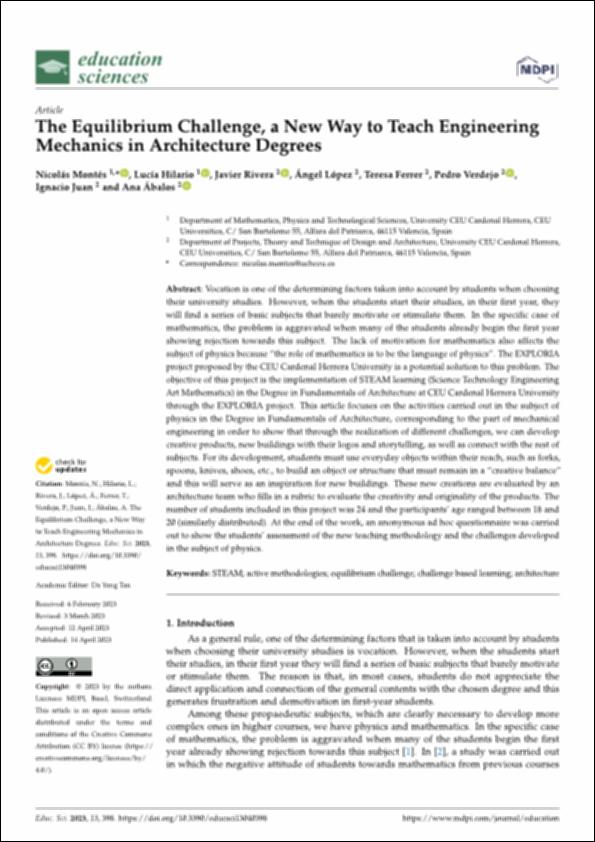Please use this identifier to cite or link to this item:
http://hdl.handle.net/10637/15188The equilibrium challenge, a new way to teach engineering mechanics in Architecture degrees
| Title: | The equilibrium challenge, a new way to teach engineering mechanics in Architecture degrees |
| Authors : | Montés Sánchez, Nicolás Hilario Pérez, Lucía Rivera Linares, Javier López de Ocari Olmos, Ángel Ferrer Dasí, Teresa Verdejo Gimeno, Pedro Juan Ferruses, Ignacio Ábalos Ramos, Ana |
| Keywords: | Arquitectura; Architecture; Ingeniería mecánica; Mechanical engineering; Universidad; Universities; Enseñanza; Teaching; Método de enseñanza; Teaching methods |
| Publisher: | MDPI |
| Citation: | Montés, N., Hilario, L., Rivera, J., López, Á., Ferrer, T., Verdejo, P., Juan, I. & Ábalos, A. (2023). The equilibrium challenge, a new way to teach engineering mechanics in Architecture degrees. Education Sciences, vol. 13, i. 4, art. 398 (14 apr.). DOI: https://doi.org/10.3390/educsci13040398 |
| Abstract: | Vocation is one of the determining factors taken into account by students when choosing their university studies. However, when the students start their studies, in their first year, they will find a series of basic subjects that barely motivate or stimulate them. In the specific case of mathematics, the problem is aggravated when many of the students already begin the first year showing rejection towards this subject. The lack of motivation for mathematics also affects the subject of physics because “the role of mathematics is to be the language of physics”. The EXPLORIA project proposed by the CEU Cardenal Herrera University is a potential solution to this problem. The objective of this project is the implementation of STEAM learning (Science Technology Engineering Art Mathematics) in the Degree in Fundamentals of Architecture at CEU Cardenal Herrera University through the EXPLORIA project. This article focuses on the activities carried out in the subject of physics in the Degree in Fundamentals of Architecture, corresponding to the part of mechanical engineering in order to show that through the realization of different challenges, we can develop creative products, new buildings with their logos and storytelling, as well as connect with the rest of subjects. For its development, students must use everyday objects within their reach, such as forks, spoons, knives, shoes, etc., to build an object or structure that must remain in a “creative balance” and this will serve as an inspiration for new buildings. These new creations are evaluated by an architecture team who fills in a rubric to evaluate the creativity and originality of the products. The number of students included in this project was 24 and the participants’ age ranged between 18 and 20 (similarly distributed). At the end of the work, an anonymous ad hoc questionnaire was carried out to show the students’ assessment of the new teaching methodology and the challenges developed in the subject of physics. |
| URI: | http://hdl.handle.net/10637/15188 |
| Rights : | Open Access http://creativecommons.org/licenses/by/4.0/deed.es |
| ISSN: | 2227-7102 |
| Issue Date: | 14-Apr-2023 |
| Center : | Universidad Cardenal Herrera-CEU |
| Appears in Collections: | Dpto. Proyectos, Teoría y Técnica del Diseño y la Arquitectura |
Items in DSpace are protected by copyright, with all rights reserved, unless otherwise indicated.


